Content
Pink catharanthus is a highly decorative plant with valuable healing properties. Medicinal raw materials are used in official and folk medicine.
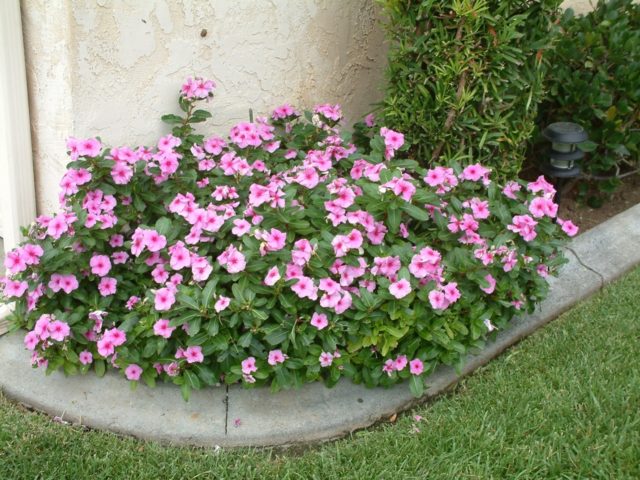
Multi-colored catharanthus - a spectacular decoration for any garden and balcony
Where grows
Catharanthus pink, or periwinkle, (Latin name - Vinca rosea) is a low evergreen shrub, belongs to the Kutrovy family. Synonymous designations - Lochner pink and pervikl. Periwinkle, growing in the tropics and subtropics, reaches a height of 0.6 m. It is characteristic of the jungles of Madagascar, Southeast Asia.
In the conditions of the middle zone, the tropical periwinkle until recently spread as an indoor culture, it was quite rare. In the Kuban and the Caucasus, small plantations of pink catharanthus are grown for the needs of pharmaceuticals. The height of the bush is up to 30 cm.
In the European part of the country, in a moderately warm climate, a species of periwinkle is grown in gardens. In terms of properties, it differs from pink catharanthus. Periwinkle is a ground cover that often retains leathery, glossy leaves under snow, especially in winter with mild frosts. In spring, a small periwinkle curtain up to 12-14 cm high is covered with lilac-blue flowers, 2-2.5 cm in diameter.
Chemical composition
Catharanthus affects the human body, due to the presence of special substances - up to 100 alkaloids, about 80 of which prevent the development of cancer cells. Specific antineoplastic alkaloids of pink vinca are included in pharmaceutical drugs. In addition to these important substances for the treatment of destructive diseases, the greens of pink periwinkle are rich in micro- and macroelements. Allocate a sufficient amount of calcium, potassium, magnesium, zinc, iron and others. Despite the significant healing properties of pink periwinkle, it also has many contraindications.
Varieties
Breeders are constantly working on the emergence of new hybrids of periwinkle, which is a true decoration of flower beds and container compositions. Florist shops offer a wide selection of catharanthus in different corolla colors. Especially bright and expressive petals are in the Tatu and Pacific varieties, which have several varieties that differ in shades.
Black Cherry
The periwinkle variety Black Cherry has a rich color of petals - an intense pink-burgundy color shimmers into a velvety black patina with the play of light. Catharanthus rose vinca Tattoo Black Cherry blooms for a long time, almost all summer. Corolla 4 to 6 cm in diameter. The compact bush branches magnificently, more than half a meter in diameter, without going beyond 20 cm in height.
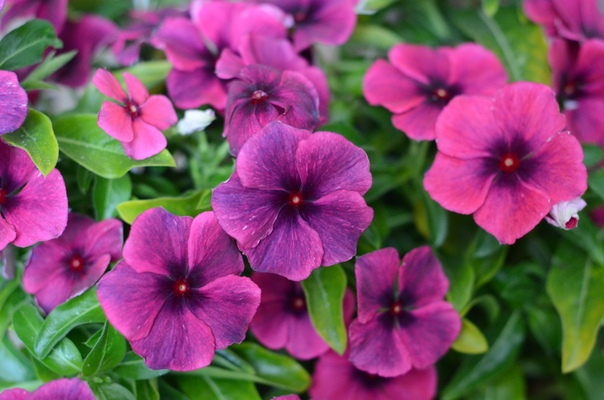
In the Tatu variety, the effect of luminescence from the corolla is noted at a certain time of the day.
Papaya
An interesting coloring at the corollas of the pink catharanthus Tatu Papaya, which have beautiful, delicate transitions of peach-salmon tints.
The leaves are lanceolate dark green, brightly emphasizing the delicate beauty of the Papaya variety. Corollas 4-6 cm wide. Vinca buds open throughout the summer.
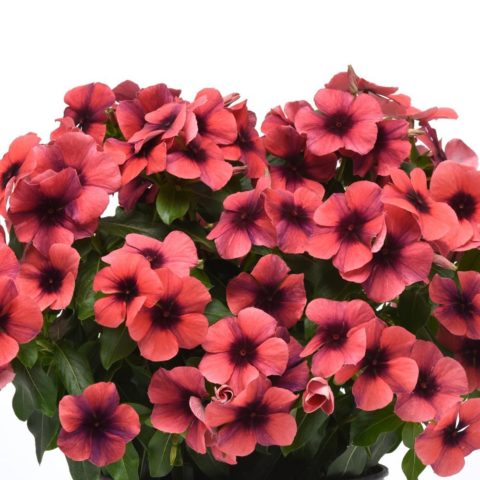
The middle is very rich, dark, like all varieties of periwinkle Tatu, with subtle tints of intense pink turning into purple
Rusberry
Rose wine catharanthus petals Tat Rasberry, according to reviews, are distinguished by a delicate, gentle carmine color. The shades of the corolla echo with the raspberry nuances, but without the dark saturated color. The bush in full bloom amazes with the tenderness of the color emanating from the opened buds. The rich greenery of dense leaves is a winning backdrop for graceful flowers. The Tattoo Raspberry plant is highly branched, the lashes extend up to 50 cm.

To make the bush seem more magnificent, several roots of periwinkle pink Rusberry are planted in one pot
Pacific
The Pacifica catharanthus cultivar is known for its charming corolla coloration. Pacific is characterized by a variety of shades ranging from deep pink, turning into purple, to white with a pink center. In the Catharanthus Pacifica Pink Ice, petals of the lightest carmine color emanate from a deep pink center. An early flowering bush actively forms new shoots with buds, rises to 30-35 cm. The crown spreads up to 40-50 cm. Before flowering, the bush is overgrown with dense, leathery, dark green leaves.

Flowers are large, over 4-5 cm
Dandy
The flowers of periwinkle pink, or catharanthus, Dandy, can be of various shades, as seen on the branded packaging, from burgundy pink to bluish-lilac and white with a raspberry center. Long flowering. Miniature bushes are exposed to the sun and provide abundant watering for lush bloom.
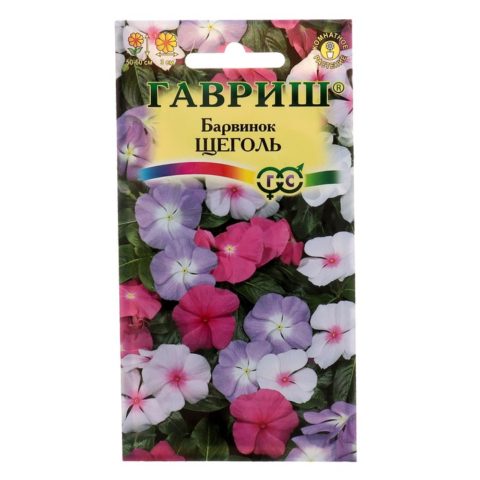
Seeds of the Dauguin variety can be selected according to the designations on the package: the main criterion is color
Burgundy
Belongs to the Catharanthus pink Pacific variety and expressive Burgundy. Periwinkle corollas have a delightful shade of intense burgundy color, which is associated with the classic version of the visual perception of Burgundy wine. The middle of the flower is light, which favorably emphasizes the color of the petals. The plant is very spectacular, ideal for balcony landscaping.
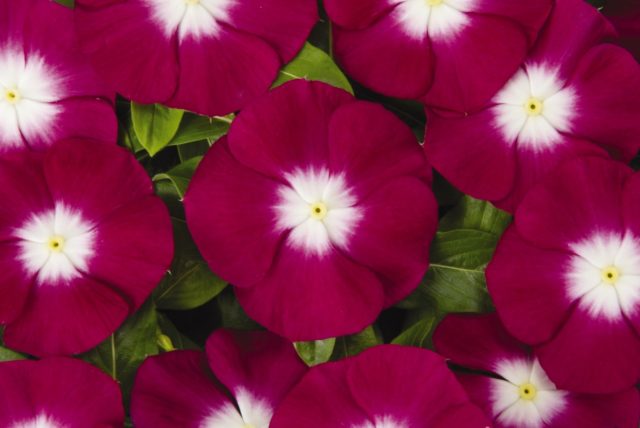
The height of the periwinkle bush is up to 30 cm
The healing properties of pink catharanthus
Catharanthus became known to US scientists as a medicinal plant after World War II. American soldiers stationed in the Philippine Islands could not get the insulin needed for some in time and were treated using periwinkle leaves on the advice of local healers.
By investigating the sugar-lowering ability of a tropical plant, the researchers made an important discovery. In animals already sick with leukemia, which were tested in the laboratory, there were positive changes in the blood formula. This is how the alkaloids of catharanthus were identified, which prevent the development of metastases: vincaleucoblastine and lerocristine.
Healers of Southeast Asia and Madagascar use extracts from catharanthus for cancer, trophic ulcers, diseases of the lungs, intestines, urinary organs and hypertension. Periwinkle pink is also used as an antibiotic, in addition to the recognized hypotensive, antitumor and antispasmodic properties.
Application in medicine
More in-depth research on the plant has led to the development of anticancer drugs in various countries. In Russia, Rosevin is known, used to treat malignant tumors and fungal mycosis. Although a complete cure with the drugs of this plant cannot be achieved. In addition, toxic substances negatively affect the body. In official medicine, such medicines are known based on pink catharanthus: Rosevin, or Vinblastine in international practice, Vincristine, Vinorelbin, Vindesin.
Folk remedies
Traditional healers of Indonesia, India, Sri Lanka and Madagascar, where pink periwinkle is widespread, use extracts from its raw materials in the treatment of diarrhea, tropical fever, and malaria.With the help of funds from a flowering shrub, wounds are healed, they alleviate the condition after insect bites, with toothache, as well as increased pressure, since in the catharanthus, just like in the periwinkle, there is a substance called reservin. Traditional healers use their recipes to cure hemorrhoids, prostate, uterus with fibroids and polyps.
In Russia, a popular recipe for pink periwinkle as a blood purifier if the lymphatic system is affected by a malignant tumor. Dried leaves of pink periwinkle (2 tablespoons) are poured with 250 ml of 70% alcohol and insisted for 10 days in a place where light does not penetrate, at a temperature of 20 ° C. Then the tincture is filtered and taken 60 minutes before meals three times a day according to the following schedule:
- the first 14 days in 50 ml of water dissolve 5 drops of tincture;
- 7 days of rest;
- 10 drops of tincture are dissolved in 50 ml of water and taken for 14 days;
- 7 days of rest.
The rose periwinkle medicine is taken in this algorithm for 8 weeks, taking a week break every 14 days. Treatment is started again after 3 months.

A beautiful medicinal plant, but the anticarcinogenic properties of tropical periwinkle do not lead to full recovery
With inflammation of the small and large intestine, skin diseases, non-healing wounds of various origins, gangrene, an aqueous infusion of pink periwinkle is taken orally:
- 1 tbsp. l. dry leaves are covered with 250 ml of boiling water;
- continue to boil for 25-30 seconds;
- cool for half an hour;
- filter;
- drink, dissolving 1 tsp. in 50 ml of water, 1 hour before meals, 2 or 3 times a day.
Skin diseases such as dermatitis, eczema, psoriasis, fungal infections are treated by applying compresses from an alcoholic extract of catharanthus.
Procurement and storage of raw materials
Catharanthus leaves are harvested from August 20 to September 10-15. They are laid out in a room where the direct rays of the sun do not penetrate, but there is a stream of air. Medicinal raw materials are suitable for a year, according to other sources - within 3 years.
Contraindications
Catharanthus pink has a lot of toxic substances that cause side effects in the body when taking medications. Allergic reactions or burns may appear on the skin after compresses. It is contraindicated to take any drugs based on pink periwinkle:
- pregnant and lactating;
- children;
- patients with low blood pressure;
- those who have a predisposition to allergies.
Conclusion
Pink catharanthus will decorate any flower arrangement in the garden and on the balcony. Dry raw materials of a tropical plant will help alleviate severe diseases.








